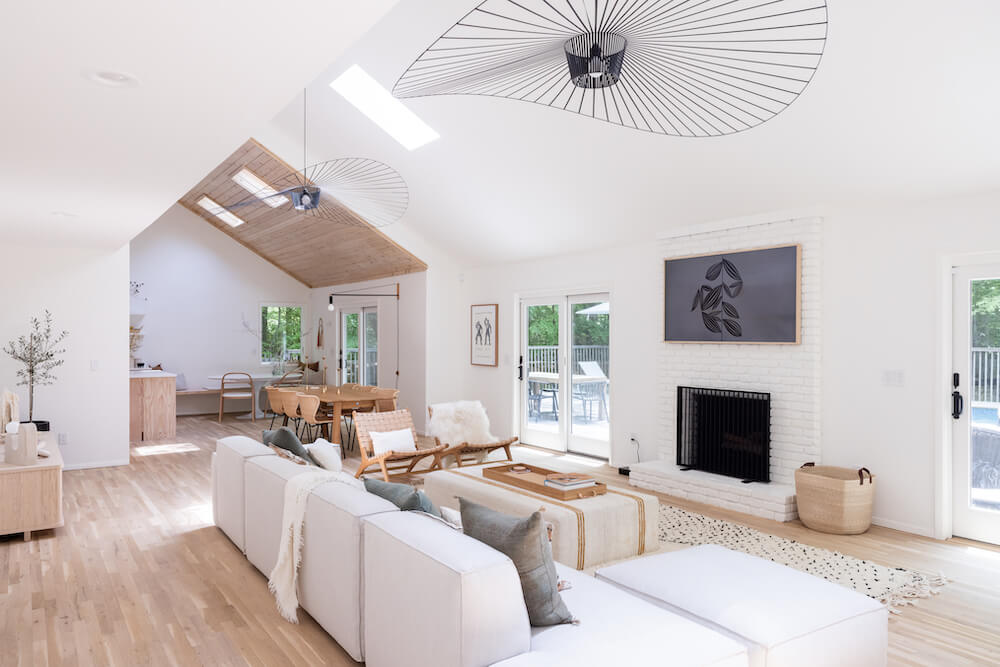7 Winter Home Renovations You Can Do and Shouldn’t Do
Winter has arrived, and the nesting instinct is strong. But before you grab your tools, let’s discuss 7 popular winter home renovation projects. We’ll share the good, the bad, and the ugly, so you can avoid common mistakes and create a cozy haven.
Winter home renovations you can do
Interior Painting
- Color Psychology and Your Space: For example, using calming blues in bedrooms and energizing yellows in kitchens. Consider consulting a color consultant to help you choose the right colors for your space.
- Paint Finishes 101: Flat finishes are great for hiding imperfections on ceilings, while semi-gloss is ideal for trim and doors. High-gloss finishes are durable and easy to clean, making them a good choice for high-traffic areas.
- Winter Painting Prep: Use a quality paintbrush and roller to ensure smooth application. Proper preparation is key to a successful paint job.
- Efficient Painting Techniques: Consider using a paint sprayer for large, flat surfaces. Cutting in around windows and doors can be time-consuming, but it’s important to take your time to get a clean line.
- Painting Around Obstacles: Use painter’s tape to protect trim and other surfaces. For more complex shapes, use a small brush to cut in.
- Color Schemes for Small and Large Spaces: For small rooms, use light, neutral colors to create an illusion of space. For large rooms, use bold colors to add warmth and personality. Consider using a color wheel to help you choose complementary colors.
- Post-Painting Maintenance: Clean walls with a mild detergent and water. Touch up any chips or scratches with a small paintbrush. Regular maintenance can help to keep your paint job looking its best.
Average cost: $500 – $2,000, depending on room size and paint quality. Sweeten brings homeowners an exceptional renovation experience by personally matching trusted general contractors to your project, while offering expert guidance and support—at no cost to you. Renovate expertly with Sweeten

Kitchen Upgrades
- Small Appliance Upgrade: Consider investing in a high-quality blender or food processor. These appliances can save you time and energy in the kitchen.
- Illuminate Your Kitchen: Under-cabinet lighting can be a great way to illuminate countertops. Consider using LED lights, which are energy-efficient and long-lasting.
- Maximize Kitchen Storage: Use drawer dividers and shelf organizers to keep your kitchen clutter-free. Consider adding a pantry or pantry cabinet to maximize storage space.
- Backsplash Beauty: Subway tile is a classic and affordable option for backsplashes. Other popular backsplash materials include ceramic tile, glass tile, and natural stone.
- Countertop Transformation: Quartz countertops are durable and low-maintenance. Granite countertops are also popular, but they can be more expensive.
- Energy-Efficient Kitchen: Choose Energy Star-certified appliances to save energy and money. Consider upgrading to a high-efficiency dishwasher or refrigerator.
- Faucet and Sink Upgrade: A modern, single-handle faucet can add a touch of style to your kitchen. Consider a touchless faucet for added convenience.
Average cost: $1,000 – $10,000, depending on the extent of the upgrades.
Bathroom Remodel
- Tile Your Way: Ceramic tile is a popular and affordable option for bathroom floors and walls. Porcelain tile is a more durable option, but it can be more expensive.
- Tub or Shower, or Both?: A walk-in shower can be a great option for people with mobility issues. A combination tub and shower can be a versatile option for families.
- Vanity and Countertop: A double-sink vanity can be a great option for families. Consider using a durable countertop material, such as quartz or granite.
- Illuminate Your Bathroom: Recessed lighting can create a spa-like atmosphere. Consider using dimmers to control the lighting level.
- Plumbing Fixture Upgrade: A low-flow toilet can help you save water. A high-efficiency showerhead can also help to reduce water usage.
- Ventilation Matters: A bathroom exhaust fan can help to remove moisture and odors. Consider installing a humidity sensor to automatically turn the fan on and off.
- Smart Bathroom Tech: A voice-activated mirror can be a convenient way to control your bathroom lighting and music. Smart toilets can offer features such as heated seats and automatic flushing.
Average cost: $5,000 – $20,000, depending on the extent of the remodel.
Energy Efficiency Upgrades
- Window Wisdom: Double-pane windows can help to reduce heat loss in the winter. Consider replacing old, drafty windows with energy-efficient models.
- Insulation Installation: Proper insulation can help to keep your home warm in the winter and cool in the summer. Consider adding insulation to your attic, walls, and basement.
- Smart Thermostat Control: A programmable thermostat can help you save energy by automatically adjusting the temperature based on your schedule. Consider using a smart thermostat with voice control.
- Lighten Your Load: LED light bulbs use less energy than traditional incandescent bulbs. Consider replacing all of your incandescent bulbs with LED bulbs.
- HVAC System Tune-Up: Regular maintenance can help to improve your HVAC system’s efficiency. Consider scheduling a professional tune-up once or twice a year.
- Seal the Deal: Caulk and weatherstripping can help to seal up air leaks around doors and windows. Inspect your home for air leaks and seal them up to improve energy efficiency.
- Home Energy Audit: A professional energy auditor can identify areas where you can improve your home’s energy efficiency. Consider making energy-efficient upgrades to your home, such as installing solar panels or a geothermal heating and cooling system.
Average cost: $500 – $5,000, depending on the specific upgrades.
Winter home renovations you shouldn’t do
Major Structural Changes
- Foundation Issues: Signs of foundation problems include cracks in the walls or floors, uneven floors, and doors or windows that stick. Addressing foundation issues is a complex and costly process, best left to experienced professionals.
- Load-Bearing Wall Removal: Removing a load-bearing wall can compromise the structural integrity of your home. This type of project requires careful planning and execution by a qualified contractor.
- Home Expansions: Major home additions can be disruptive and expensive. They also require permits and inspections, which can be more difficult to obtain during the winter months.
- Framing and Structural Reinforcement: These projects can be messy and time-consuming. They also require specialized skills and knowledge.
- Roof Replacement: Roofing in winter can be dangerous and difficult. Cold temperatures can make it difficult to work on a roof, and snow and ice can create hazardous conditions.
- Extensive Plumbing and Electrical Work: Winter weather can make it difficult to access and repair plumbing and electrical systems. Frozen pipes and power outages can complicate matters.
- Demolition: Demolition can create a lot of dust and debris, which can be a problem in winter weather. It’s also important to dispose of construction waste properly, which can be more difficult during the winter months.
Average cost: Varies widely depending on the specific project. For major structural changes, costs can range from tens of thousands to hundreds of thousands of dollars.
Exterior Painting
- Freezing Temperatures: Paint may not adhere properly to surfaces in freezing temperatures. Cold weather can also slow down the drying process, leading to uneven paint application and potential damage to the paint job.
- Damp and Moldy Surfaces: Painting over damp or moldy surfaces can lead to paint failure. It’s important to address any moisture issues before painting to ensure a long-lasting finish.
- Choosing the Right Paint: Use a high-quality exterior paint that is designed to withstand the elements. Consider using a paint with a higher sheen, such as semi-gloss or gloss, as these finishes are more durable and easier to clean.
- Proper Surface Preparation: Clean and scrape surfaces to remove any loose paint or dirt. Proper surface preparation is essential for a good paint job.
- Painting in Inclement Weather: Rain, snow, and high humidity can interfere with the drying process. Painting in these conditions can lead to poor adhesion and premature paint failure.
- Protecting Your Surroundings: Cover plants and other surfaces with drop cloths to protect them from paint spills. It’s also important to clean up any spills immediately to prevent damage to your property.
- Priming for Protection: A good primer can help to improve paint adhesion and durability. It can also help to hide imperfections in the surface and create a uniform base for the topcoat.
Average cost: $1,000 – $5,000, depending on the size of the project and the type of paint used.
Roofing and Siding Replacement
- Extreme Weather Conditions: Strong winds and heavy snow can damage roofing and siding materials. Winter storms can also make it difficult for contractors to access your home and complete the work.
- Icy and Snowy Conditions: Working on a roof in icy conditions is dangerous. It’s important to wait for the weather to improve before starting any roofing or siding work.
- Subpar Materials and Installation: Use high-quality materials and hire a reputable contractor. Poorly installed roofing and siding can lead to leaks, water damage, and energy inefficiency.
- Interior Damage: Protect your home’s interior from water damage by covering floors and furniture. It’s also important to keep an eye on the weather during the project and take steps to protect your home from water intrusion.
- Sealing and Insulation: Proper sealing and insulation can help to improve your home’s energy efficiency. It’s important to seal any gaps or cracks around windows, doors, and other openings.
- Gutter and Downspout Maintenance: Clean gutters and downspouts to prevent water damage. Clogged gutters can lead to water damage to your roof and foundation.
- Landscape Protection: Protect your landscaping from damage by covering plants and shrubs. You may also want to consider removing delicate plants from the work area.
Average cost: $5,000 – $20,000, depending on the size of your home and the materials used.
Landscaping Projects
- Frozen Ground: It is difficult to dig and plant in frozen ground. Working in frozen soil can damage plants and make it difficult to create a clean, finished look.
- Winter Fertilizing and Pesticides: Applying fertilizers and pesticides in winter can harm plants and pollute the environment. It’s best to wait until spring to fertilize and treat your lawn and garden.
- Icy Conditions: Working in icy conditions can be dangerous. It’s important to wait for the ice to melt before working in your yard.
- Irrigation System Installation: Installing an irrigation system in winter can damage the system and your landscaping. Freezing temperatures can damage pipes and sprinkler heads.
- Tree and Shrub Pruning: Prune trees and shrubs in late winter or early spring. Pruning in winter can stress plants and make them more susceptible to disease.
- Mulching: Apply a layer of mulch to help protect plants from freezing temperatures. Mulch can also help to conserve moisture and suppress weeds.
- Plant Protection: Use frost cloth or other protective coverings to protect delicate plants from freezing temperatures. You can also bring potted plants indoors to protect them from the cold.
We can help plan your renovation
Find endless home renovation inspiration, detailed guides, and practical cost breakdowns from our blogs. You can also post your project on Sweeten today and get matched with our vetted general contractors and get estimates for free!












